There’s no such thing as a vacant lot, of course. Every lot is full of history. And some lots are fuller—much fuller—than others. I offer as evidence the lot at 1730 Stella Street:
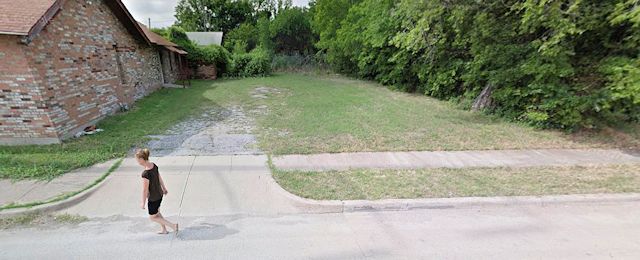 This vacant lot is just off Riverside Drive in Glenwood. If this vacant lot could talk to that woman hurrying past, she would hear of the house of just 952 square feet that sat on the lot for a half-century beginning in 1908. She would hear of that house’s occupants over the years and of the memories of those occupants. She might listen with particular interest to the memories of one former occupant as he recalled his cousins Frank and Jesse James, Cole and Jim Younger, Quantrill’s Raiders, the Ku Klux Klan, the Franco-Prussian War, Australian bushmen, New Zealand Maori warriors, South African Zulu warriors—all parts of the past as told by the old man who a century ago lived at 1730 Stella Street and worked as a humble mattressmaker at a factory three blocks away. No doubt he simply walked those three blocks to work each day.
This vacant lot is just off Riverside Drive in Glenwood. If this vacant lot could talk to that woman hurrying past, she would hear of the house of just 952 square feet that sat on the lot for a half-century beginning in 1908. She would hear of that house’s occupants over the years and of the memories of those occupants. She might listen with particular interest to the memories of one former occupant as he recalled his cousins Frank and Jesse James, Cole and Jim Younger, Quantrill’s Raiders, the Ku Klux Klan, the Franco-Prussian War, Australian bushmen, New Zealand Maori warriors, South African Zulu warriors—all parts of the past as told by the old man who a century ago lived at 1730 Stella Street and worked as a humble mattressmaker at a factory three blocks away. No doubt he simply walked those three blocks to work each day.
But a half-century before he walked to work and made mattresses, William Wyeth James rode to work on a “gallant steed” and made war on his perceived enemy.
 Will James, born in Mississippi in 1848, spent “most of his boyhood,” the Star-Telegram wrote, “in the company of . . . Old Natch,” a Natchez Native American who instilled in the boy a knowledge of woodcraft. Years later James recalled that by 1862 he was fourteen, recovering from malarial fever, and living with relatives in Independence, Missouri—near the Kansas-Missouri border. This change of address would color James’s outlook for the rest of his life. (Photo shows James at age forty-five.)
Will James, born in Mississippi in 1848, spent “most of his boyhood,” the Star-Telegram wrote, “in the company of . . . Old Natch,” a Natchez Native American who instilled in the boy a knowledge of woodcraft. Years later James recalled that by 1862 he was fourteen, recovering from malarial fever, and living with relatives in Independence, Missouri—near the Kansas-Missouri border. This change of address would color James’s outlook for the rest of his life. (Photo shows James at age forty-five.)
Since 1854 the Kansas-Missouri border had been the battleground of “Bleeding Kansas,” the era of violent confrontations between anti-slavery “free-staters” (Jayhawkers) of Kansas Territory and pro-slavery partisans (“border ruffians”) of the state of Missouri.
Bleeding Kansas was a dress rehearsal for the Civil War.
In 1861 Kansas became a (free) state, the Civil War began, and violence along the Kansas-Missouri border continued. In early 1862, James recalled years later, a band of Jayhawkers attacked the house where he was living with relatives in Independence. Young James killed eight of the Jayhawkers, he claimed. Suddenly the boy of fourteen was a wanted man: a wanted man filled with hate. For the rest of his life Will James would carry a grudge the way other men carry a pocket watch. In his memoirs, written just before his death, he remained filled with hate for the “unprincipled rascality of the Yankee politician” and “wretched and unspeakable” Kansas. He remembered the “awful state of affairs on the Missouri-Kansas border, the Missouri planters being kept in a state of anxiety watching for a visit from those rascally, thieving Kansans.”
The Star-Telegram wrote, “He never spoke of a Kansan without the use of adjectives indicative of the contempt his soul had for them.”
In July 1862 fourteen-year-old Will James found an outlet for that contempt: He joined Quantrill’s Raiders.

 Quantrill’s Raiders was a band of pro-Confederate bushwhackers who fought in the Civil War under the leadership of Ohio schoolteacher-turned-guerrilla William Clarke Quantrill, perpetuating the violence of Bleeding Kansas along the Kansas-Missouri border. Relying largely on ambush and hit-and-run raids, Quantrill’s Raiders attacked “free-state” Kansans, pro-Union militia, Union troops, and even undefended towns. The Union army had standing orders: Shoot or hang Quantrill’s Raiders on sight. (Photo from Wikipedia.)
Quantrill’s Raiders was a band of pro-Confederate bushwhackers who fought in the Civil War under the leadership of Ohio schoolteacher-turned-guerrilla William Clarke Quantrill, perpetuating the violence of Bleeding Kansas along the Kansas-Missouri border. Relying largely on ambush and hit-and-run raids, Quantrill’s Raiders attacked “free-state” Kansans, pro-Union militia, Union troops, and even undefended towns. The Union army had standing orders: Shoot or hang Quantrill’s Raiders on sight. (Photo from Wikipedia.)
In his memoirs Will James referred to Quantrill’s men as “Quantrill’s boys” because most of them were under twenty years of age. The youngest was twelve. Most of the raiders, James said, had a personal reason, just as he had, for joining the guerrilla band—a grievance against Yankee soldiers or Kansas Jayhawkers.
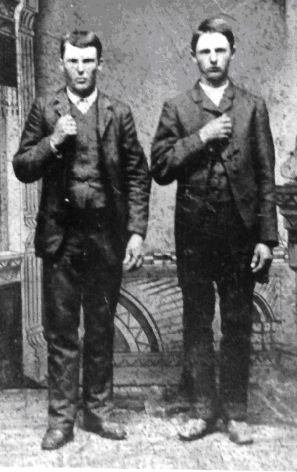 By 1862 Quantrill’s band numbered one hundred; by 1863 it would number four hundred. Also riding with Quantrill were brothers Cole and Jim Younger and Will James’s three cousins Jesse and Frank James (pictured; 1872 photo from Wikipedia) and Francis Marion “Tuck” Hill.
By 1862 Quantrill’s band numbered one hundred; by 1863 it would number four hundred. Also riding with Quantrill were brothers Cole and Jim Younger and Will James’s three cousins Jesse and Frank James (pictured; 1872 photo from Wikipedia) and Francis Marion “Tuck” Hill.
Will James would later complain that history had misunderstood Cole Younger, that Younger’s father had been murdered by “Kansas bushwhackers,” that Kansans had forced Cole’s mother to set fire to her own house, and that Kansans had murdered “a beautiful girl, a cousin of Cole’s.”
James in his memoirs recalled details of life as a Quantrill’s Raider: “Our uniform was a wide-brimmed black hat, the left brim fastened to the crown by a silver or gold cross and crescent. . . . We all wore bushwhacker shirts, many of them made of black velvet . . . dark trousers, cavalry boots and Mexican spurs with not less than four pistols.”
As guerrillas, James recalled, Quantrill’s Raiders were often night fighters, “and when we were safe we would sing the call”:
Then rouse, my brave boys, up! up! and away.
Press hard to the foe, ’ere the dawn of the day.
Look well to your steeds, so gallant in chase.
We’ll never give o’er till we win in the race.
We’ll sheathe not a sword, we’ll slack not a rein
Till Missouri is free from the Federals again.
Will James recalled one anecdote that showed the hatred rife along the Kansas-Missouri border. One day William Quantrill was out of percussion caps for his pistol. He sent James from camp into nearby Olathe, Kansas, to buy some caps. Leaving town with the caps, James was stopped by a suspicious Kansas sergeant. James said he stabbed the sergeant in the arm with a spur, shot him between the eyes, and fled. The commanding officer, outraged, ordered an Olathe woman—a Southerner and Quantrill sympathizer—to sew a shroud for the dead sergeant. The woman told the commanding officer that she would comply and would also gladly make shrouds for the remainder of the Union army.
James recalled an attack in 1862:
“Shortly before the capture of Independence [Missouri] by [Confederate Colonel Upton] Hays and Quantrill, George Todd [a Quantrill lieutenant] . . . heard of a convoy of clothes and provisions heading for Independence and determined to cut them off. . . . we heard a big noise and found it to be a bunch of enemies. There were about 100 of them. I went after George Shepherd [a Quantrill lieutenant] as fast as I could and he brought his men (about ten of us all) riding as quietly as we could part of the way, and then dismounting went the rest of the way on foot. George told us to station ourselves under cover and when we were ready he went out and called to the enemies to surrender. They had lighted several fires and were cooking coffee and bacon while singing and having a general good time. When called to surrender they were muchly surprised and made for their guns and began to load. They blazed away without seeing where we were or what they were firing at. Seeing that they intended to fight, George gave the orders to fire. In a few moments the Kansans were either down, dead or on the run.”
 But Quantrill’s deadliest raid came on August 21, 1863 when he led four hundred men in an attack on Lawrence, Kansas. Raiders set the town on fire, looted the banks, and killed any male civilian old enough to hold a rifle. Almost two hundred civilians were killed; more than two hundred homes and businesses burned. Clip is from the New York Tribune.
But Quantrill’s deadliest raid came on August 21, 1863 when he led four hundred men in an attack on Lawrence, Kansas. Raiders set the town on fire, looted the banks, and killed any male civilian old enough to hold a rifle. Almost two hundred civilians were killed; more than two hundred homes and businesses burned. Clip is from the New York Tribune.
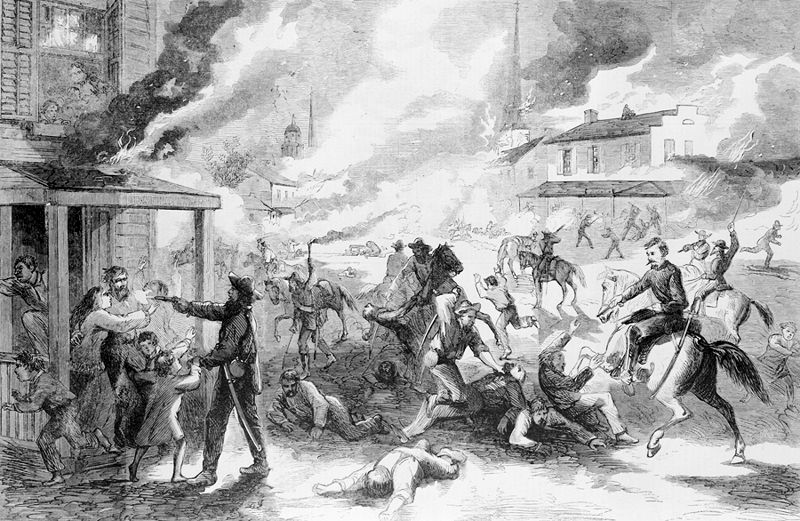
 Harper’s Weekly magazine depicted Quantrill’s attack on Lawrence, Kansas. (Photos from Wikipedia.)
Harper’s Weekly magazine depicted Quantrill’s attack on Lawrence, Kansas. (Photos from Wikipedia.)
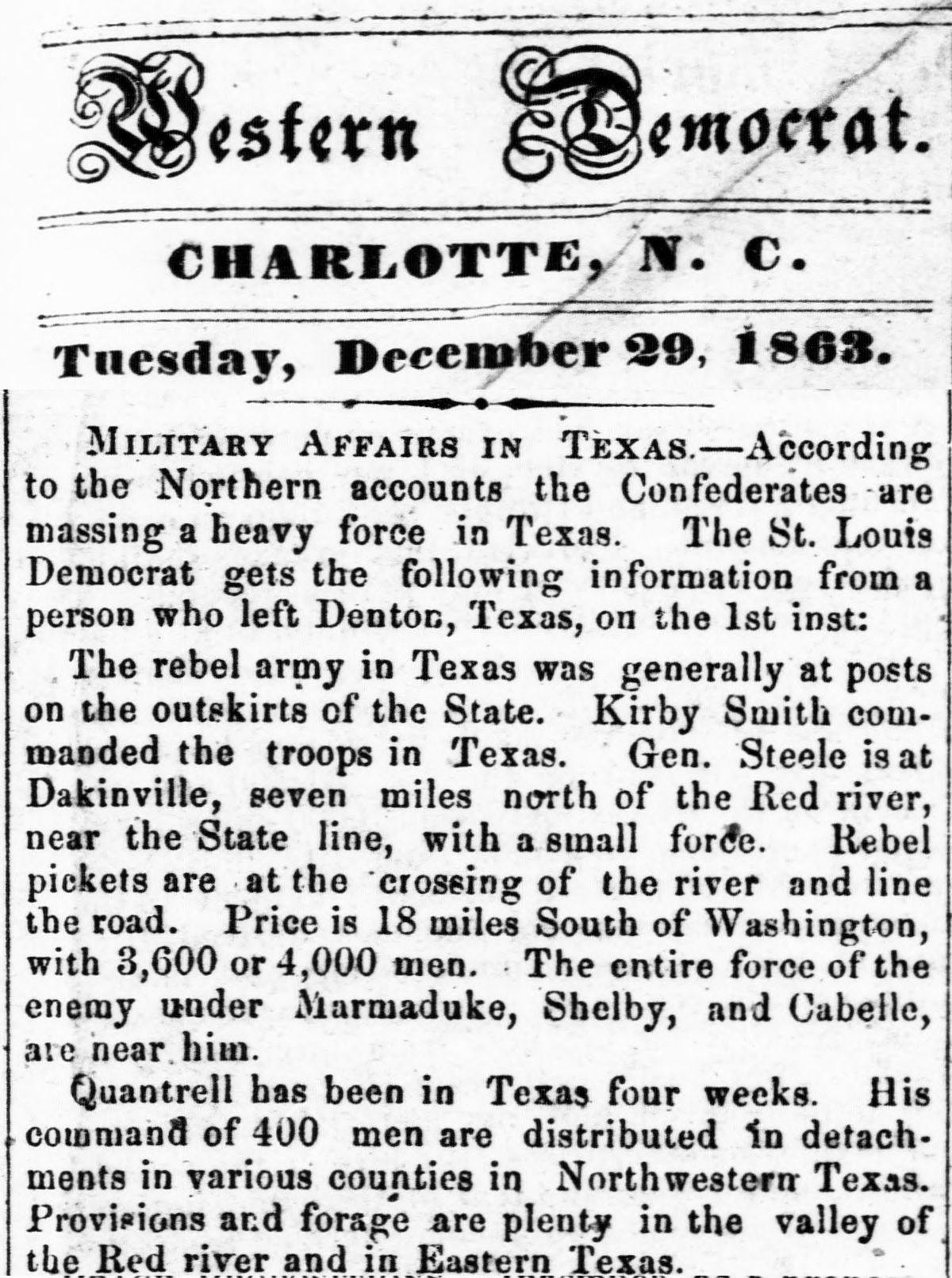 To avoid Northern retribution for the Lawrence massacre, Quantrill and his men skedaddled south, spending the winter of 1863-1864 in Texas about twenty miles from Sherman. Confederate General Henry McCullough assigned Quantrill’s Raiders to pursue deserters, conscription (draft) dodgers, and raiding Native Americans. But, according to the Texas State Historical Association, Quantrill’s men began to raid local civilians, and the Confederate army had to assign regular troops to protect civilians from Quantrill’s irregulars!
To avoid Northern retribution for the Lawrence massacre, Quantrill and his men skedaddled south, spending the winter of 1863-1864 in Texas about twenty miles from Sherman. Confederate General Henry McCullough assigned Quantrill’s Raiders to pursue deserters, conscription (draft) dodgers, and raiding Native Americans. But, according to the Texas State Historical Association, Quantrill’s men began to raid local civilians, and the Confederate army had to assign regular troops to protect civilians from Quantrill’s irregulars!
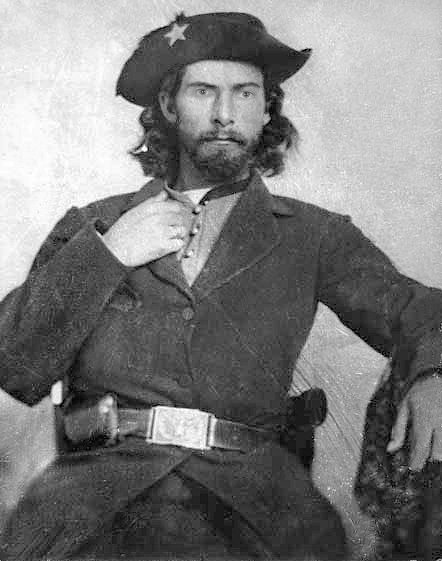 Meanwhile, dissension among Quantrill’s men led them to splinter, reorganizing as bands led by “Bloody Bill” Anderson (photo from Wikipedia), George Todd, and Quantrill. Finally, in late March 1864 General McCullough had William Quantrill arrested for ordering the murder of a Confederate major. Quantrill (perhaps framed by Anderson) escaped from jail and, pursued by state and Confederate troops, fled Texas with only a fraction of his four hundred men.
Meanwhile, dissension among Quantrill’s men led them to splinter, reorganizing as bands led by “Bloody Bill” Anderson (photo from Wikipedia), George Todd, and Quantrill. Finally, in late March 1864 General McCullough had William Quantrill arrested for ordering the murder of a Confederate major. Quantrill (perhaps framed by Anderson) escaped from jail and, pursued by state and Confederate troops, fled Texas with only a fraction of his four hundred men.
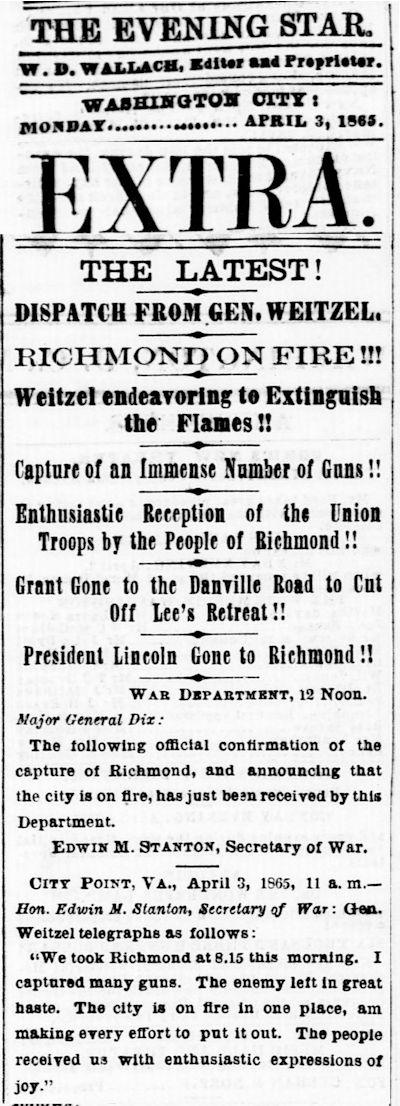 Fast-forward to April 1865. On April 3 Richmond, Virginia, the Confederate capital, fell.
Fast-forward to April 1865. On April 3 Richmond, Virginia, the Confederate capital, fell.
 And on April 9 General Lee surrendered his Army of Northern Virginia to General Grant at Appomattox. Clip is from the Alexandria Gazette of Virginia.
And on April 9 General Lee surrendered his Army of Northern Virginia to General Grant at Appomattox. Clip is from the Alexandria Gazette of Virginia.
 However, hostilities did not cease immediately. In June came two more events: On June 6 William Clarke Quantrill died at age twenty-seven after being shot in May in a skirmish in Kentucky, and on June 22 the last shot of the Civil War was fired. Clip is from the Cleveland Daily Leader.
However, hostilities did not cease immediately. In June came two more events: On June 6 William Clarke Quantrill died at age twenty-seven after being shot in May in a skirmish in Kentucky, and on June 22 the last shot of the Civil War was fired. Clip is from the Cleveland Daily Leader.
William Clarke Quantrill (and, by extension, his raiders) remains controversial. A folk hero to many Southerners during the war, today he is regarded by some historians as a “pathological killer” who used the war as a pretext for crime.
With Quantrill dead and the war over, Frank and Jesse James and Cole and Jim Younger were suddenly out of work. Regrouping as the James-Younger Gang, they used what they had learned from Quantrill’s hit-and-run tactics as they began to rob banks and trains.
Cousin Will James, wounded three times as a raider, went in another direction, although for the three James boys violence would remain the tie that binds. The Civil War was just the first of six wars that William Wyeth James claimed to have fought in. After the Civil War, as cousins Frank and Jesse branched out into armed robbery, Will joined the Ku Klux Klan, fought for France in the Franco-Prussian War in 1870 and rose to the rank of captain after suffering a saber wound while retaking a French flag from three Prussians, took a “whack” at insurgent Bushmen in Australia (and was wounded by a boomerang), fought the Maori indigenous people of New Zealand, was awarded a Victoria Cross while fighting with the British army against the Zulus in South Africa in 1879, and, finally, took part in a filibustering expedition in Bolivia in South America. He returned to the States in 1880.

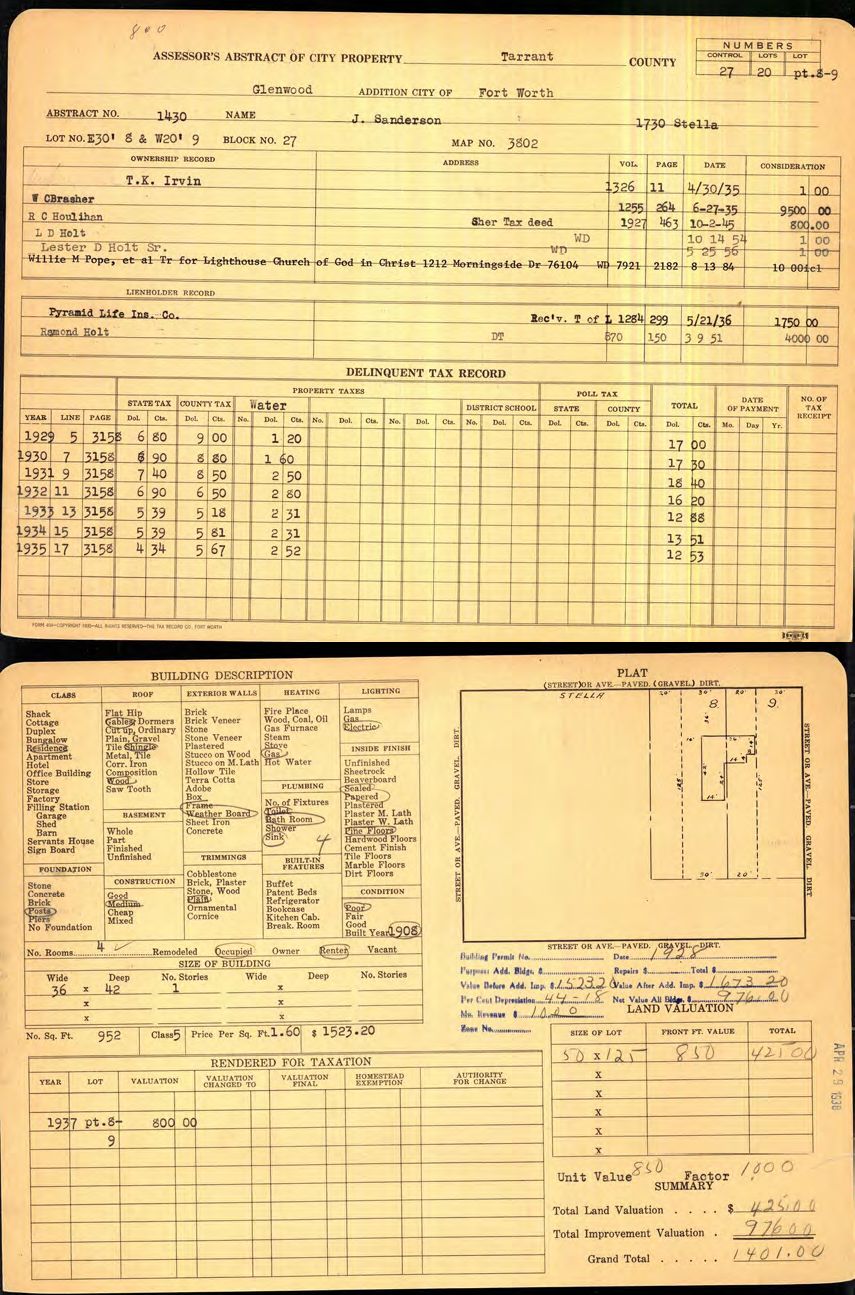 By 1913 William Wyeth James, the old Quantrill’s Raider, was living quietly in Fort Worth, working as a mattressmaker at Hub Furniture Company, located just three blocks from his little four-room rented house on Stella Street.
By 1913 William Wyeth James, the old Quantrill’s Raider, was living quietly in Fort Worth, working as a mattressmaker at Hub Furniture Company, located just three blocks from his little four-room rented house on Stella Street.
 Meanwhile alumni of Quantrill’s Raiders held reunions into the twentieth century. In this photo, some say, the man labeled “FJ” is Frank James. (Photo from Wikipedia.)
Meanwhile alumni of Quantrill’s Raiders held reunions into the twentieth century. In this photo, some say, the man labeled “FJ” is Frank James. (Photo from Wikipedia.)
 Will’s cousin Jesse James had been shot to death in 1882, but surviving cousins and former Quantrill’s Raiders Frank and Will James and Francis Marion “Tuck” Hill held their own family reunions. Tuck Hill owned a ranch at Clarendon. His house in McKinney, which he built in 1877, still stands.
Will’s cousin Jesse James had been shot to death in 1882, but surviving cousins and former Quantrill’s Raiders Frank and Will James and Francis Marion “Tuck” Hill held their own family reunions. Tuck Hill owned a ranch at Clarendon. His house in McKinney, which he built in 1877, still stands.
Frank James died in 1915, leaving William Wyeth as the last James boy standing.
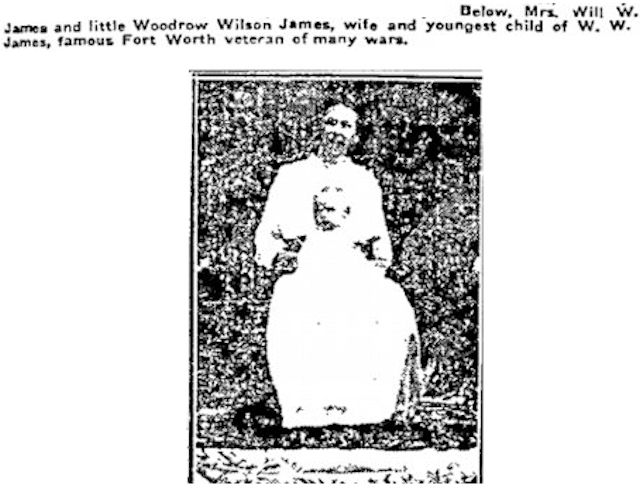 In that year of 1915 Woodrow Wilson was president. In Europe the “great war” raged, although America had thus far stayed out of it. Will James was a great admirer of President Wilson. James, then sixty-seven, named his newborn son “Woodrow Wilson James.”
In that year of 1915 Woodrow Wilson was president. In Europe the “great war” raged, although America had thus far stayed out of it. Will James was a great admirer of President Wilson. James, then sixty-seven, named his newborn son “Woodrow Wilson James.”
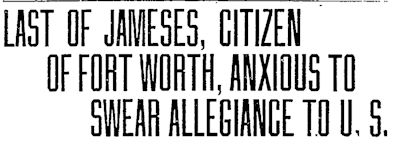 In fact, James’s admiration for President Wilson was so great that in 1916 James decided to make a grand gesture: The old Rebel, after a half-century, would surrender to the enemy—the Union—by signing an oath of allegiance to the United States. The Star-Telegram had called James a “man without a country” because the country (the Confederacy) he had sworn allegiance to fifty-five years earlier had almost as long ago ceased to exist.
In fact, James’s admiration for President Wilson was so great that in 1916 James decided to make a grand gesture: The old Rebel, after a half-century, would surrender to the enemy—the Union—by signing an oath of allegiance to the United States. The Star-Telegram had called James a “man without a country” because the country (the Confederacy) he had sworn allegiance to fifty-five years earlier had almost as long ago ceased to exist.
James said he had believed that a general amnesty declaration by President Andrew Johnson in the late 1860s had required that Rebels take an oath of allegiance to the Union. James also said that doubt of his U.S. citizenship had been planted in his mind by cousin Frank: “Frank told me [that as a Rebel] I did not have as much to do with the President of the United States as some Dutchman who has just landed in the United States.”
Despite being assured that signing an oath was not necessary, Will James said he wanted to sign an oath anyway “to attest his feeling toward the Wilson administration.”
 And so it was that at 11 a.m. on September 19, 1916 for William Wyeth James the federal courthouse on Jennings Avenue became his Appomattox, and U.S. Commissioner George W. Mitchell became his Ulysses S. Grant. Standing before U.S. Commissioner Mitchell and a U.S. flag in a federal courtroom, William Wyeth James signed an oath of allegiance to the United States, thus officially recognizing the U.S. government for the first time since 1861.
And so it was that at 11 a.m. on September 19, 1916 for William Wyeth James the federal courthouse on Jennings Avenue became his Appomattox, and U.S. Commissioner George W. Mitchell became his Ulysses S. Grant. Standing before U.S. Commissioner Mitchell and a U.S. flag in a federal courtroom, William Wyeth James signed an oath of allegiance to the United States, thus officially recognizing the U.S. government for the first time since 1861.
The old Quantrill’s Raider had surrendered to the Yankees. For William Wyeth James the war was over.
 “I have been an outlaw since 1862,” James told Mitchell. “I was outlawed by General [Henry] Halleck, the Yankee general, in 1862. I have been one ever since. They gave orders to catch us and hang us. Well, they trapped some of our men, and hung us—but they never got me.”
“I have been an outlaw since 1862,” James told Mitchell. “I was outlawed by General [Henry] Halleck, the Yankee general, in 1862. I have been one ever since. They gave orders to catch us and hang us. Well, they trapped some of our men, and hung us—but they never got me.”
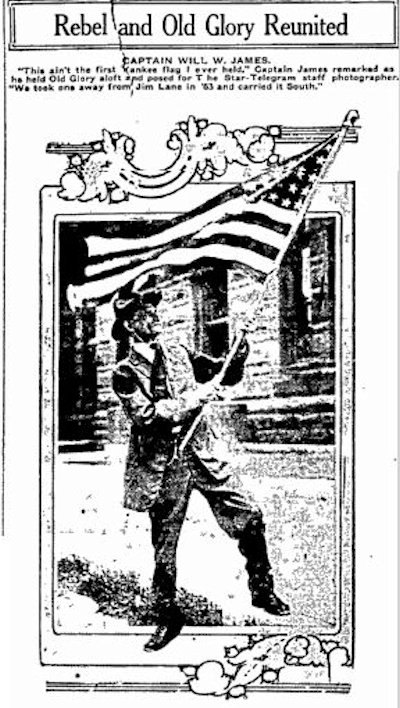 Back in the Union at last in 1916, after fighting in six wars was the old soldier ready to fade away? Not by a long shot. Will James told the Star-Telegram, “Lord! How I’d like to go to Mexico [where U.S. soldiers under General Pershing were chasing Pancho Villa]. I’m 68, and they won’t let me fight, but I can ride and I can hide and I can shoot, sir. Lots of the young soldiers don’t know how to hide. They think it’s cowardly, but don’t you know, sir, that a dead soldier ain’t worth a continental? You want to keep a soldier alive as long as you can so he can kill lots of other soldiers.”
Back in the Union at last in 1916, after fighting in six wars was the old soldier ready to fade away? Not by a long shot. Will James told the Star-Telegram, “Lord! How I’d like to go to Mexico [where U.S. soldiers under General Pershing were chasing Pancho Villa]. I’m 68, and they won’t let me fight, but I can ride and I can hide and I can shoot, sir. Lots of the young soldiers don’t know how to hide. They think it’s cowardly, but don’t you know, sir, that a dead soldier ain’t worth a continental? You want to keep a soldier alive as long as you can so he can kill lots of other soldiers.”
“I am a little old, but I am just as active as a boy, and I’m ready to fight for the flag in Mexico or Europe or anywhere else the President orders me.”
(By some newspaper accounts, after America entered World War I in 1917, James, then sixty-nine, still having a bad taste in his mouth from the Franco-Prussian War of 1870, tried to enlist to fight the Germans but was turned away because of his age.)
 But William Wyeth James did fight one more battle. And on June 16, 1920 he lost that battle. But William Wyeth James—Quantrill’s Raider, soldier of fortune, and for a half-century an “unreconcilable and unreconstructed Rebel”—died having made his peace with the states of the Union.
But William Wyeth James did fight one more battle. And on June 16, 1920 he lost that battle. But William Wyeth James—Quantrill’s Raider, soldier of fortune, and for a half-century an “unreconcilable and unreconstructed Rebel”—died having made his peace with the states of the Union.
Well, maybe not Kansas.
(Thanks to retired Fort Worth police sergeant and historian Kevin Foster for the tip.)






I am a descendant of John W Kegin who was one of Quantrills Raiders. I’m really interested in genealogy of my family name. Would you have any information on him?
I’m sorry, but this post is all the information I have. But the Internet and print resources have a lot about the Raiders.
My husband is a gr gr grandson of John W Kegin and I have been researching the Kegin geneology for some time so do have some information.
Please email me and we can talk.
William, if you will look on the internet for the William Clarke Quantrill Society and they have at newsletter called The No Quarterly, the April 2017 issue has an article about John W. Kegin called Jesse James’ Six Shooter.
Where was William James buried?
Mount Olivet, although Find a Grave has no listing.
I am seeking info if William Wyeth James had any sons? I am a fourth grand son to Will Melton James who came from Lebannon Missouri moved to Fort Worth Texas around 1880 and was born in Missouri in 1865 but my family stops at Will James? I was always beleived to be related to Frank and Jesse but can not prove it could you help me in anyway? My name is Jared Leonard phone # 8179443918
I have e-mailed you censuses for 1920 and 1930. . . . The e-mail bounced back. In addition to the son Woodrow Wilson James mentioned in the post, William Wyeth James had at least eight children, including two sons not counting Woodrow Wilson James. The censuses show sons William and Woodrow Wilson and a third son I can’t read. Looks like Hillburn. In 1930 the widow and children were in Columbus, Mississippi. Only sons Woodrow Wilson and William were with the family in 1930.
Hi,
I am the great grand daughter of Tuck Hill.
I didn’t remember that he owned a ranch in Clarendon. Where did you get this information?
I knew that he raised and sole donkeys but I never knew where he did that.
Of course, I didn’t pay attention to all the stories I heard when I was little about him. I wish now that I had.
Thank you,
Ms. Kilgore, I have e-mailed you the 1916 newspaper article that says Hill owned a ranch near Clarendon.
I grew up at 1633 East Stella Street. This empty lot was on the next block. It isn’t often at all I see my old neighborhood mentioned in ANYTHING. It is a forgotten part of Fort Worth, but I LOVE my old neighborhood and all of its stories, problems, challenges, and triumphs. It raised me. Thank you for this information.
Thanks, Traci. Having grown up “next door” in Poly, I have enjoyed learning about Glenwood, North Glenwood, Hub Furniture, Tyler’s Lake, etc.
I liked the history you presented here. But the section on Quantrill in Texas may be misplaced . There is a monument to him in the town square of Sherman.If fools today haven’t tore it down.
I read it, still can not believe all the history included. I will read it again. My brain can only hold so much. Thanks Mike. A good break from the politics and wars of this day.
Thanks, Ramiro. Fascinating little bit of history. I wasn’t sure I’d be able to stop researching and writing.
Outstanding work!
Thanks, Kevin, and thanks for the tip. This one grabbed me from the start and would not let go.